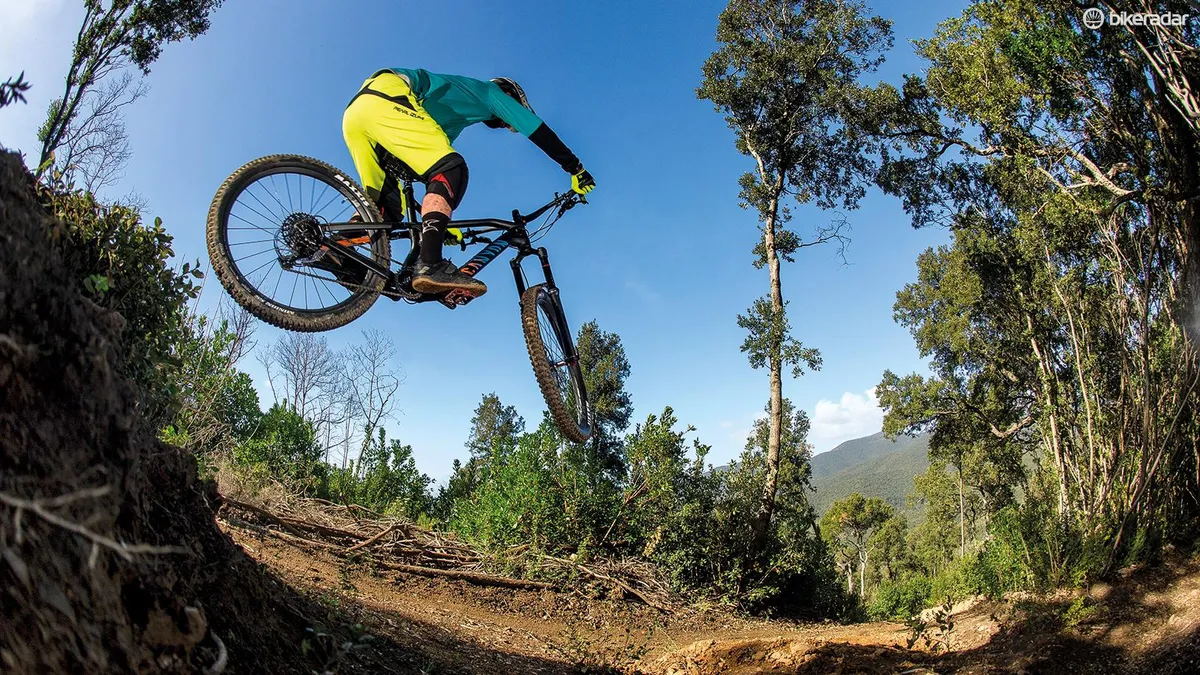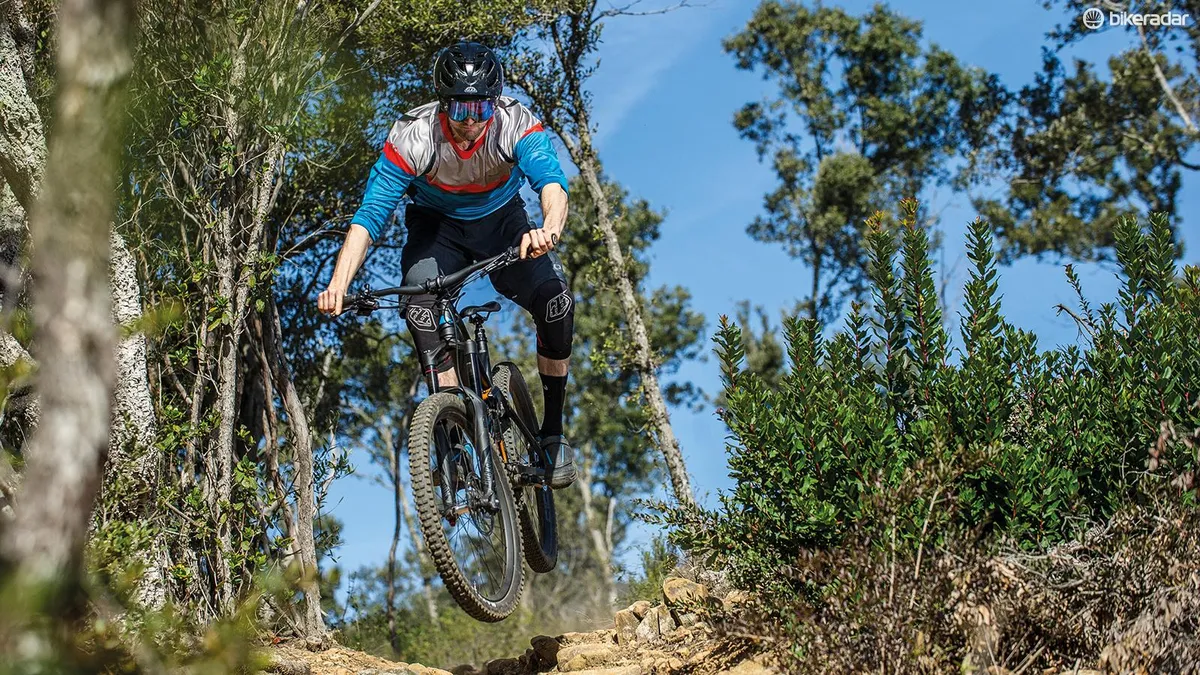We were first introduced to Canyon’s hard hitting trail/enduro bike back in 2014. Having been designed under the watchful eye of multiple downhill World Champ and EWS race winner, Fabien Barel, the Canyon Strive’s performance, as you’d expect, didn’t disappoint. Three years on though, can it still cut it against the best out there?
- BikeRadar's Bike of the Year 2017 awards — this year's categories revealed
- Canyon bikes reviews and buying advice
While quite a few trail bikes offer some form of geometry transformation, albeit by flipping chips somewhere on the frame or altering the rear dropout, there are few that can make these changes on the fly. The Strive can. The idea is to offer some subtle tweaks to the geometry and suspension to make this 163mm travel rig a touch easier to pedal back up the hills. Canyon has managed this by using its ShapeShifter unit — a small piston and knuckle-link configuration which is located just below the frame's rocker link.

Push the bar mounted lever (you’ll also need to throw your weight backwards for the DH mode or lift yourself upwards and forwards to engage the XC mode) and the ShapeShifter unit will shift the shock forward or backwards in the frame, altering the head and seat tube angles by 1.5 degrees, lifting the bottom bracket and firming up the suspension as well as limiting its travel to 130mm. While it’s maybe not the easiest thing to do while you’re trucking down through a race stage or particularly technical trail, it’s a doddle to master if you want to make climbs a little less painful.Aside from this innovative bit of tech, Canyon certainly doesn’t scrimp on detail elsewhere on the Strive, including the neatly internally routed cables, which are securely channeled into the frame using screwed inserts — meaning there are zero cable rattle issues.
The 163mm of travel comes courtesy of the Horst Link suspension design and is controlled using a RockShox Monarch Plus RC3 DebonAir damper.
In the Downhill mode, the head angle is claimed to sit at 66 degrees, which is erring on the side of conservative compared to many other current bikes with this sort of travel. Thanks to the Race geometry, my large test bike comes with a very respectable 468mm reach and a stretched out 648mm effective top tube. In the Cross-country mode, the seat tube angle sits at a decent 75 degrees, which makes for even more efficient pedalling.
Check out Bike of the Year contender the Canyon Strive AL 5.0 Race
Canyon Strive AL 5.0 Race kit
Of the three aluminium Strive ‘Race’ models, the 5.0 sits slap bang in the middle of the range. That’s not to say the spec is anywhere near some kind of middle of the road offering though. Everything here could easily belong on a much pricier bike, but then that is of course a perk of buying direct and not through a shop.
Highlights for me have to include the RockShox Lyrik RC fork, which might not have quite the same amount of adjustment as the RCT3 model, but still uses the impressively smooth and controlled Charger Damper and Solo Air spring.

Another shout out has to go to the RockShox Reverb dropper post too. Canyon didn’t go crazy when it came to seat tube length which means it can make the most of the new breed of longer droppers. In this case I’ve got the 150mm drop version, which gives plenty of clearance when totally slammed.It’s also worth mentioning the Maxxis rubber which offers decent, predictable grip without rolling too slowly. The semi-slick rear tyre won’t suit sloppy, typically British conditions though.All in the Strive AL 5.0 weighs 14.3kg, which is similar to many other bikes at this price in this category.
Canyon Strive AL 5.0 Race ride
Canyon’s direct sell, online only sales model means you need to be confident with sizing and geometry if you’re going to commit to buying the Strive. Fortunately, if you’re happy enough to buy direct, the Strive doesn’t disappoint.
Role into the first section of trail and you’ll notice just how blissfully silent things can be. Even on the choppiest Italian trail we rode, the Strive pattered down without a peep.
The rangy reach measurement translates to a stable, confident position on the bike when you’re tackling fast paced trails
Suspension balance will need a little work early on though as the Strive likes to sit quite deep into its travel. But once you’ve added some volume bands to the shock, to add a bit more ramp up and support, the 5.0 feels far better when stoved into high speed turns or launched deep into big compressions where geometry is better maintained and things feel more predictable and stable when it counts.
It’ll also happily truck through and flatten out properly roughed up sections of trail, maintaining momentum and not beating your feet up in the process. That’s not to say the ride is in anyway numb or disengaged, it’s just a little more forgiving than some bikes out there and means you don’t always need to be as precise or calculated with line choice.
When it comes to sizing, Canyon has done a sterling job. Seated climbs feel more than roomy enough as you slowly slog away up the hill, and we never suffered any issues with front wheel lift or wander when things got technical or steep.

As you’d hope, the nifty little ShapeShifter’s Cross-Country mode helps here too and after a bit of practice, doesn’t take all that much effort to actuate. This helps to keep to improve efficiency somewhat, though to be fair the Strive pedals pretty damn well in the Downhill mode as it is, which explains why some of our testers opted to not use it for the most part.
Out of the saddle and pointed downhill, it’s a similar story. The rangy reach measurement translates to a stable, confident position on the bike when you’re tackling fast paced trails, but those tight chainstays mean it doesn’t take much to lift the front of the bike up and over anything in the way.
Slide into steeper sections and you’ll be glad of that short seat tube which ensures the saddle stays well out of the way when it does get properly tricky. But it’s here where all of our testers picked up on the head angle, which measured a touch steeper than Canyon claims, sitting it closer to 67 than 66 degrees. But even at the claimed 66 degrees, it’s still between 1-2 degrees steeper than many of the Strive’s closest rivals.
While this won’t have a massive impact for a lot of riders, it does mean for those that seek out the wilder, super steep, off-piste trails things just don’t feel quite as confident. Maybe a steeper DH mode would be the answer here?
Regardless, as it is, the Strive still remains a seriously fast bike with decent proportions for the most part and a cracking spec for the cash.

